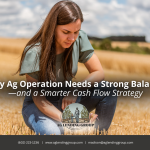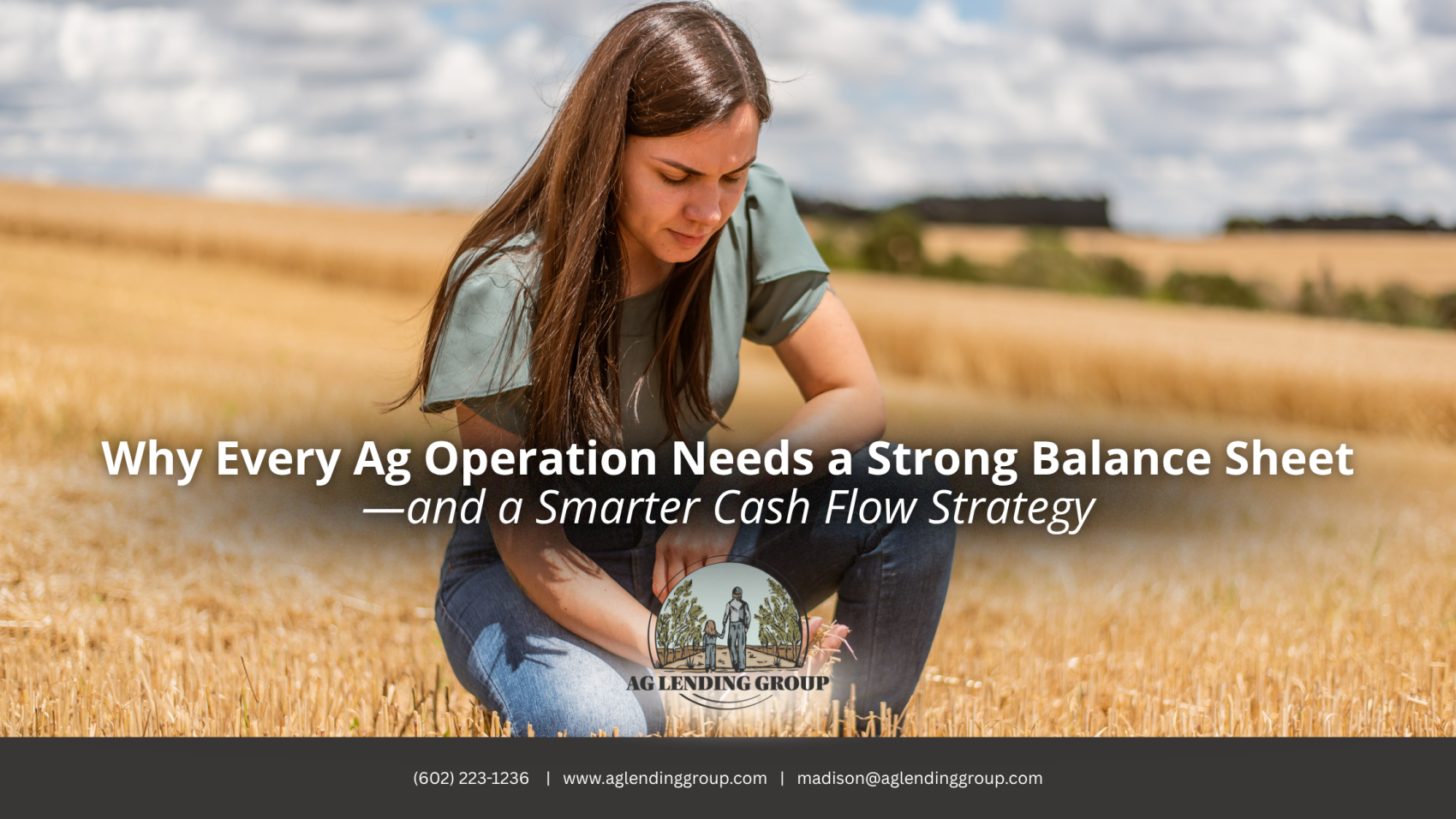
 In the world of agricultural finance, your balance sheet is one of the most critical tools for understanding your financial health. It provides a snapshot of your assets, liabilities, and equity at a given moment in time, giving you and your lender insight into the overall strength of your operation.
In the world of agricultural finance, your balance sheet is one of the most critical tools for understanding your financial health. It provides a snapshot of your assets, liabilities, and equity at a given moment in time, giving you and your lender insight into the overall strength of your operation.
However, even a strong balance sheet and a solid profit and loss (P&L) statement won’t prevent a financing crisis if you’re not managing one essential factor: cash flow. Many ag operators mistakenly assume that being profitable means being financially secure—but that’s not always the case.
This article explores why understanding and actively managing your cash flow is just as important as maintaining a balance sheet—and how both tools work together to ensure the stability and growth of your farm or ranch.
The Role of the Balance Sheet in Agriculture
A balance sheet shows what your business owns and owes at a specific point in time. It typically includes:
- Assets: Land, equipment, livestock, inventory, cash, and receivables
- Liabilities: Loans, lines of credit, accounts payable, and other debts
- Owner’s Equity: The difference between assets and liabilities—your net worth
This financial snapshot is critical for lenders evaluating your creditworthiness, and for you as an operator when making major decisions about expansion, debt, or succession planning.
Why Your Balance Sheet Matters
- Helps track changes in net worth over time
- Assists in evaluating leverage and risk
- Serves as a foundation for refinancing or new loan applications
- Supports strategic decisions like land purchases or equipment upgrades
While the balance sheet is a valuable benchmark, it doesn’t capture the timing of money moving in and out of your operation—which is where cash flow becomes essential.
Why Cash Flow Is the Oxygen of Your Operation
Even if your operation is profitable on paper, poor cash flow management can leave you unable to pay bills, make payroll, or take advantage of growth opportunities. This is how farms fail—not from a lack of profitability, but from a lack of liquidity.
A cash flow statement tracks all cash inflows and outflows over a period of time, typically month-by-month or quarter-by-quarter. It answers the fundamental question:
“Do I have enough cash on hand to meet my financial obligations as they come due?”
Unlike a balance sheet, which is static, the cash flow statement is dynamic. It shows how your finances function in real time.
Key Components of a Cash Flow Statement
To build an effective cash flow strategy, it’s important to understand the three core categories of a cash flow statement:
1. Operating Activities
These are the day-to-day financial transactions related to your ag operation.
Cash inflows may include:
- Crop and livestock sales
- Government payments and subsidies
- Custom work or side business income
- Crop insurance payouts
- Loan draws or advance payments
Cash outflows may include:
- Feed, fertilizer, seed, and fuel
- Labor and payroll
- Equipment repairs and maintenance
- Rent, mortgage, or loan payments
- Family living expenses
- Taxes and insurance
Timing matters. You record the cash when it hits your account—not when the sale is made. This distinction is vital when projecting income for the year.
2. Investing Activities
This category reflects money used to purchase or sell long-term assets:
- Buying or selling land
- Purchasing or selling breeding stock
- Building infrastructure (e.g., barns, storage facilities)
- Buying or selling major equipment
These investments can dramatically impact your available cash in a given season, even though they may benefit your operation in the long term.
3. Financing Activities
This section reflects how your operation is funded:
- Drawing or repaying lines of credit
- Taking out new loans
- Making principal payments on existing debt
These movements impact cash availability and should be planned in relation to your revenue cycle.
Common Cash Flow Mistakes in Agriculture
Many producers struggle with cash flow not because their business is unprofitable, but because of poor timing, unrealistic projections, or incomplete planning. Here are the most common mistakes ag lenders see:
Relying on Income That Hasn’t Arrived
It’s easy to plan based on projected grain checks or cattle sales. But if payments are delayed—or prices shift—your plan can unravel. Cash flow should reflect actual money in hand, not hopeful estimates.
Paying Down Debt Too Aggressively
While reducing debt is smart, doing it too fast can strip your operation of the liquidity it needs to survive unexpected events like drought, equipment failure, or input price hikes.
Forgetting Family Living and Taxes
Many operations fail to include personal living expenses and tax obligations in their cash flow planning. These are real, recurring costs and must be part of the budget if you want a full financial picture.
Ignoring Seasonality
In agriculture, expenses are constant, but income is often seasonal. If your primary income only arrives once or twice a year, your cash flow must reflect this. Otherwise, you risk running short when bills are due mid-season.
Not Building in Margin
Weather, markets, and policy changes are out of your control. That’s why your cash flow plan should include a buffer—some margin for error in case of income disruption or cost increases.
How Cash Flow Complements the Balance Sheet
Together, your balance sheet and cash flow statement tell a complete financial story:
- The balance sheet shows what you own, what you owe, and your net worth at a moment in time.
- The cash flow statement shows how money is moving—and whether your operation has the resources to continue operating smoothly.
By using both tools, you can identify opportunities to restructure debt, time purchases more effectively, and avoid unnecessary shortfalls.
The Ag Lending Group Approach
At Ag Lending Group, we specialize in helping farmers and ranchers not only access the capital they need—but also structure their finances around the reality of agricultural life.
Our lending process includes:
- Cash flow forecasting
- Debt structure analysis
- Income and expense cycle mapping
- Liquidity planning
- Real estate-backed credit strategies
We help our clients match their debt service with their income cycle, ensuring that payments fall during cash-rich seasons and that emergency funds or lines of credit are available when needed.
Whether you’re buying land, refinancing existing debt, or need a more flexible line of credit, we’ll build a custom financial strategy that protects your operation year-round—not just at tax time.
Why This Matters for Your Legacy
At the end of the day, the goal isn’t just survival—it’s sustainability.
Running a successful ag business today requires thinking like a CEO. That means making decisions based on real-time financial data, building in safety nets, and ensuring that your operation isn’t one missed payment away from collapse.
Your legacy depends on more than production. It depends on financial structure, cash flow control, and smart planning.
Ready to Strengthen Your Cash Flow?
If you’re ready to gain more control over your operation’s financial future, Ag Lending Group is here to help. We’ll work with you to create a cash flow plan that reflects your unique operation—its timing, its risk, and its long-term goals.
Visit www.aglendinggroup.com, call us at (602) 223-1236, or DM us on social media to schedule a free consultation.
Ag Lending Group — No Suits. No Ties. No Lies. Just honest, ag-focused financing built for real life.
Latest Articles
- November WASDE: What Farmers Should Know, and How to Navigate What’s Next
- How Farmers Can Prepare Their Financials for Year-End Success
- Keeping the Farm in the Family: How Ag Lending Group Helps Make It Possible
- Harvest Season Planning: Setting Your Ag Business Up for Next Year’s Success
- Why Every Ag Operation Needs a Strong Balance Sheet—and a Smarter Cash Flow Strategy